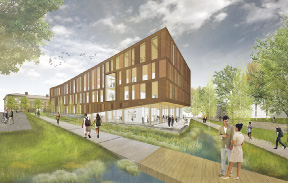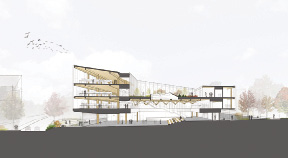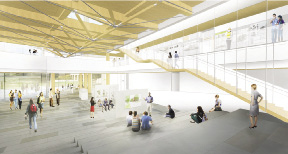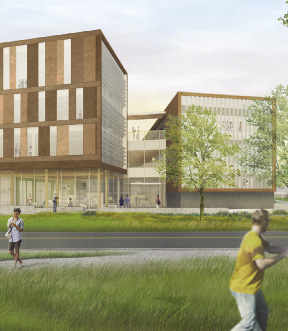Now under construction, Leers Weinzapfel Associates' Design Building at the University of Massachusetts Amherst will unite the school's dispersed programs in Landscape Architecture and Regional Planning, Architecture, and Building Technology under one roof. A dramatic demonstration of sustainable design and material research, the 80,000 GSF edifice will be one of the first institutional buildings in the Northeast to employ an engineered mass timber structure. It will be a dynamic place of exchange, collaboration, and experiment celebrating a shared commitment to the environment.
Actively demonstrating its own integrated design approach, Leers Weinzapfel secured the commission for the building through a shared presentation with landscape architects Stephen Stimson Associates. Located on a sloping site near the main campus entry, the Design Building will function as the link between the formal 1975 Haigis Mall by Pritzker Prize-winning architect Kevin Roche and the informal and intimate space of historic Stockbridge Way. A literal throughway down the hill and across the campus, it actively connects these two campus precincts. The sloped site creates a tall four-story facade on the downhill side facing the mall, inviting the community into the building. A three-story facade on the uphill side fits comfortably among smaller surrounding historic buildings.
The structure's exterior material and window strategy are informed by the rural origins of the university and its current research. A durable envelope of copper anodized aluminum panels and vertical windows suggest the color and patterns of the region's forests and trees. Initially, the firm was working with a steel frame for the design, typical of buildings of its scale and type in the northeast. The building technology faculty encouraged the firm to think about applying their area of research, engineered timber, to the project instead. They subsequently sought funding and commitment to make this a demonstration project for the state university.
Supported by a 2014 Environmental Bond Bill grant and developed by an international wood structural design team including Vancouver-based Equilibrium Consulting Engineers, the new edifice will demonstrate leading-edge timber engineering. A glue-laminated wood frame; floor slabs of composite, exposed cross-laminate timber (CLT) panels; and cast-in-place concrete comprise its key elements, punctuated by a dramatic timber "zipper" truss that spans a skylit commons.
Inside, the design of the building encourages interaction at every turn, beginning with its center space: a coiling and rising band of studios, faculty offices, and classrooms surround the skylit commons that will be used for gatherings and presentations. Above the commons, the interfacing continues as studios and offices embrace a contemplative green roof terrace and outdoor classroom.
Outside, the building's landscaping includes a palette of native plant and stone materials, which create an active storm water management system for the site. Above the commons, a green roof garden reduces the heat island effect, slows storm water run-off, and provides a cloistered environment enjoyed by students in the studios as well as faculty members at work in their offices.
The building's form is compact, which reduces the building envelope and heat loss, yet it also permits all occupied spaces to have generous natural light and views to the campus. Targeted for LEED Gold Certification, the project will be a model for the sustainable integration of building technology, landscape, and architecture for the entire campus. "We recognize that our academic clients see the potential for each building project to be a teaching tool," said principal-in-charge Andrea Leers. This combined design method can teach the lessons of sustainable design in a tangible way."
Summarizing her firm's expectations for the building, Leers observed: "We are enthused about the buzz of activity, exchange, and experiment that will result from gathering all the studios, offices, and classrooms around a common central space where the slope of the land flows through the building, the fabric of the structure reflects ongoing research, and a rooftop garden can be shared by all." Chair of the Department of Architecture Stephen Schreiber, FAIA, concurs: "The students, faculty and staff are very excited about the new collaborative research and teaching that will happen in the beautiful labs, studios, classrooms, and common areas crafted by Leers Weinzapfel and their consultants."
Project team included:
* Architect: Leers Weinzapfel Associates
* Landscape Architect: Stephen Stimson Associates
* Structural Design Engineer: Equilibrium Consulting
* Structural Engineer of Record: Simpson Gumpertz & Heger
* MEP/FP: BVH Integrated Services
* Construction Manager: Suffolk Construction












